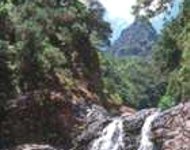|
|
|
|

|
The Laurissilva Forest of Madeira was classified as UNESCO World Natural Heritage site in December 1999. It is an outstanding relict and is the largest surviving area of a laurel forest believed to be 90% of the primary forest.
This forest type is considered to be a centre of plant diversity containing numerous rare endemic species, especially of neophytes, ferns and flowering plants. It also has a very rich invertebrate fauna. The site has a unique suite of plants and animals, including many endemic species such as the long-toed pigeon.
The origin of Laurissilva forest goes back to the Tertiary and it reached vast extensions from the South of Europe to the Mediterranean basin. With the last glaciations it disappeared of the European continent, surviving only in the Atlantic archipelagos of the Azores, Madeira and Canary islands.
The Laurissilva Forest of the Madeira island forms nowadays the remaining of a primitive covered forest which resisted to five centuries of humanisation and which made that the Portuguese navigators called the region "Madeira" (wood).
The area is part of the Natural Park of Madeira, granting it a statute of protection. In 1992 it was integrated in the Biogenetic Reserves net of the European Council and comprises a Special Protection Zone in the scope of the Directiva Aves (Bird Directive). As far as trees are concerned, the Til, the Vinhatico (tropical tree of the Mimosa family), the Laurel tree, the Barbusano (an ironwood) and all the trees of the Laurel family. It is also worth to point out the presentation of a great diversity and development of the linchen and bryophyte communities, mainly the epiphytes, besides the numerous endured endemicities, namely on the level of the shrubby and herbaceous strata. Other interesting species include the Finch of Madeira and numerous molluscs and insects. The humidity brought by the northeast wind is held and condensed by the Laurissilva, causing large streams from which depend the irrigation of the agricultural fields and the water supply to the urban centres. Since the second half of the 20th century, the water, carried along the “levadas” (narrow channels), started to produce electricity in the hydroelectric power stations. Altogether there are 2150 kms of canals, some dating back to the 16th century. The maintenance paths running alongside the “levadas”, provide a network of footpaths reaching into remote parts of the island inaccessible by road. |